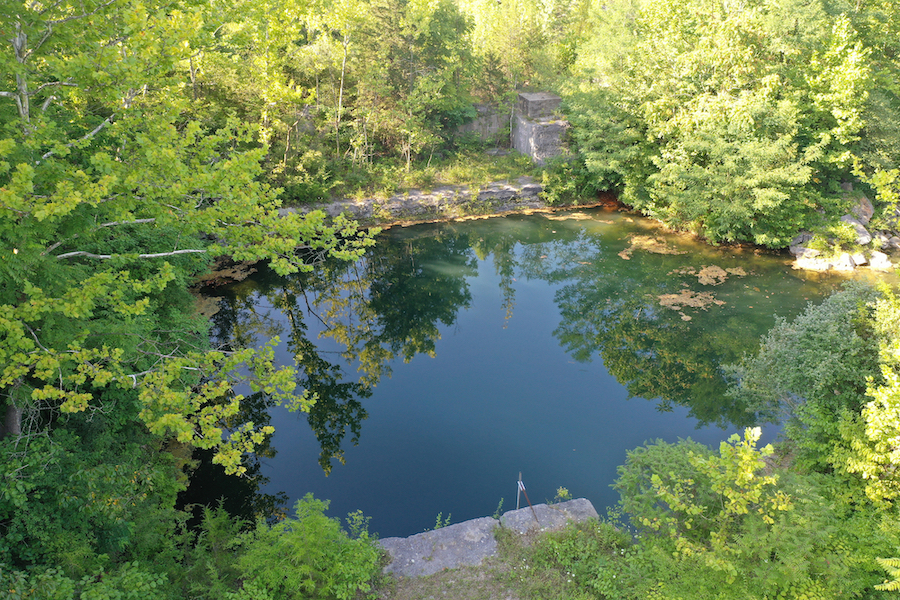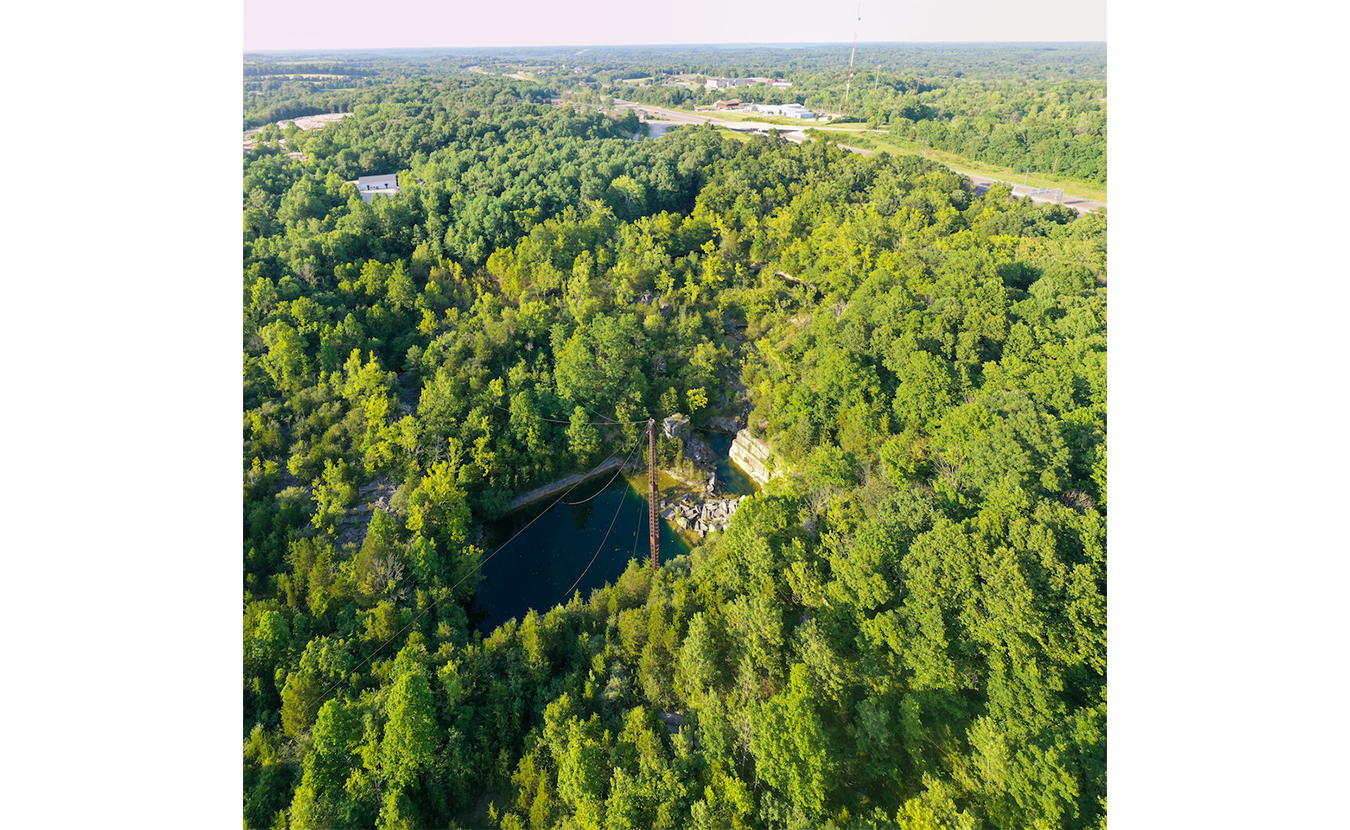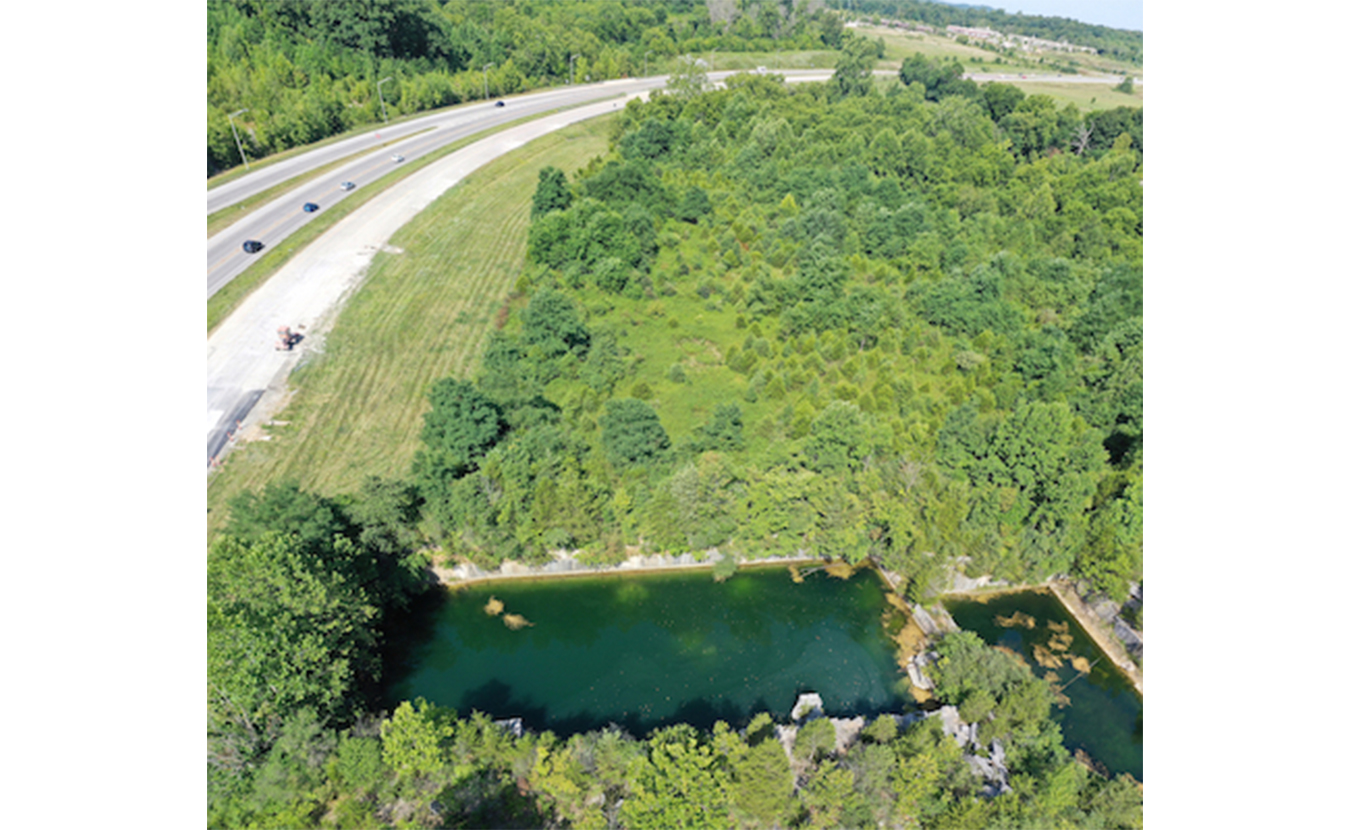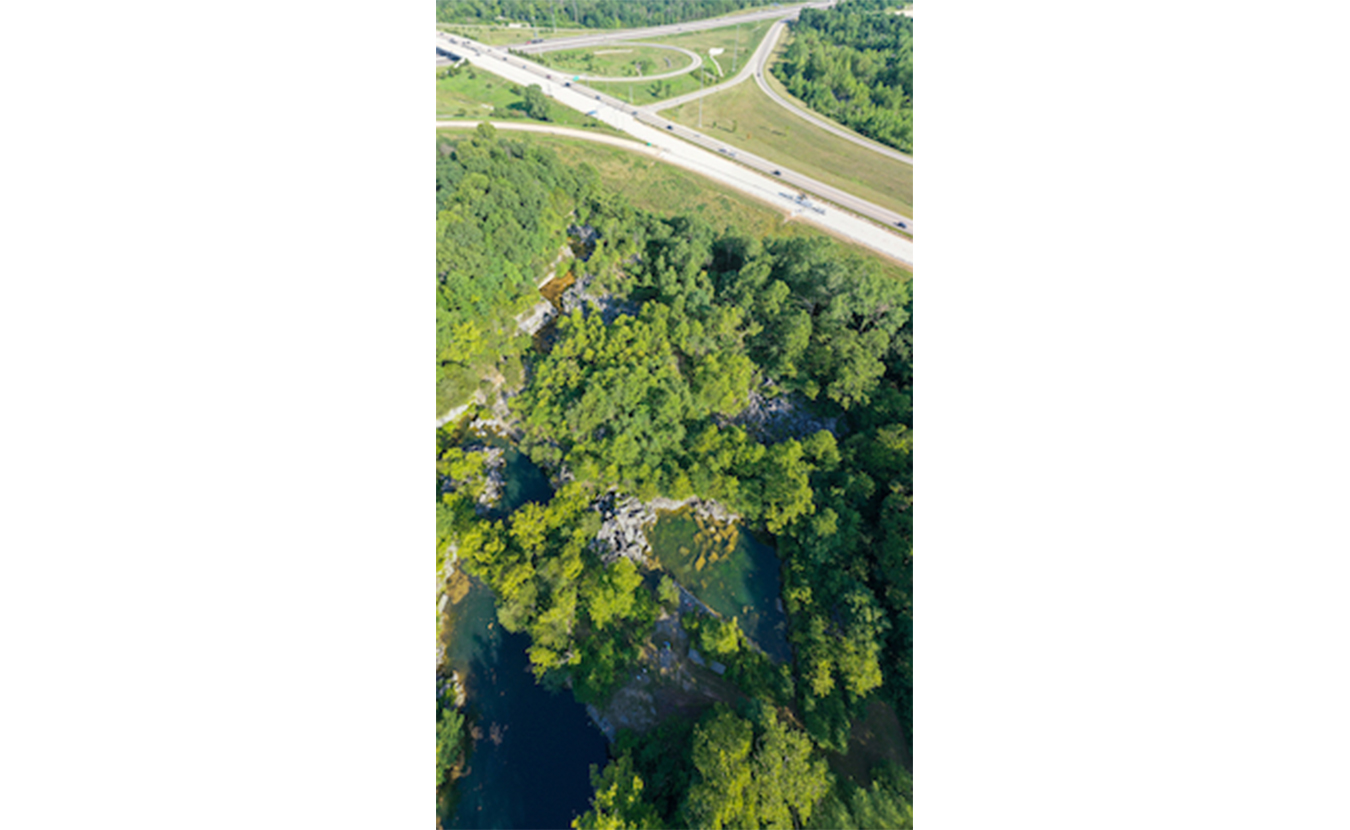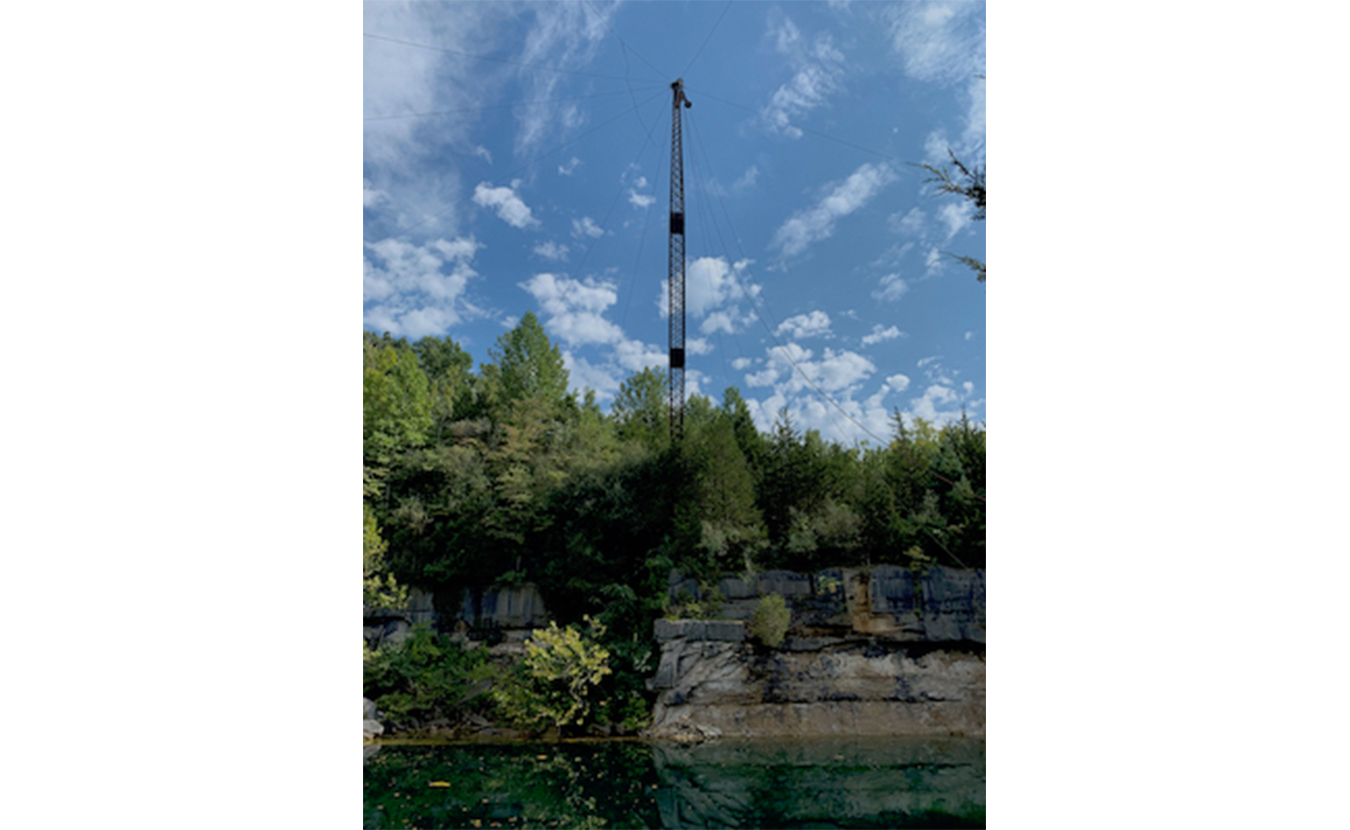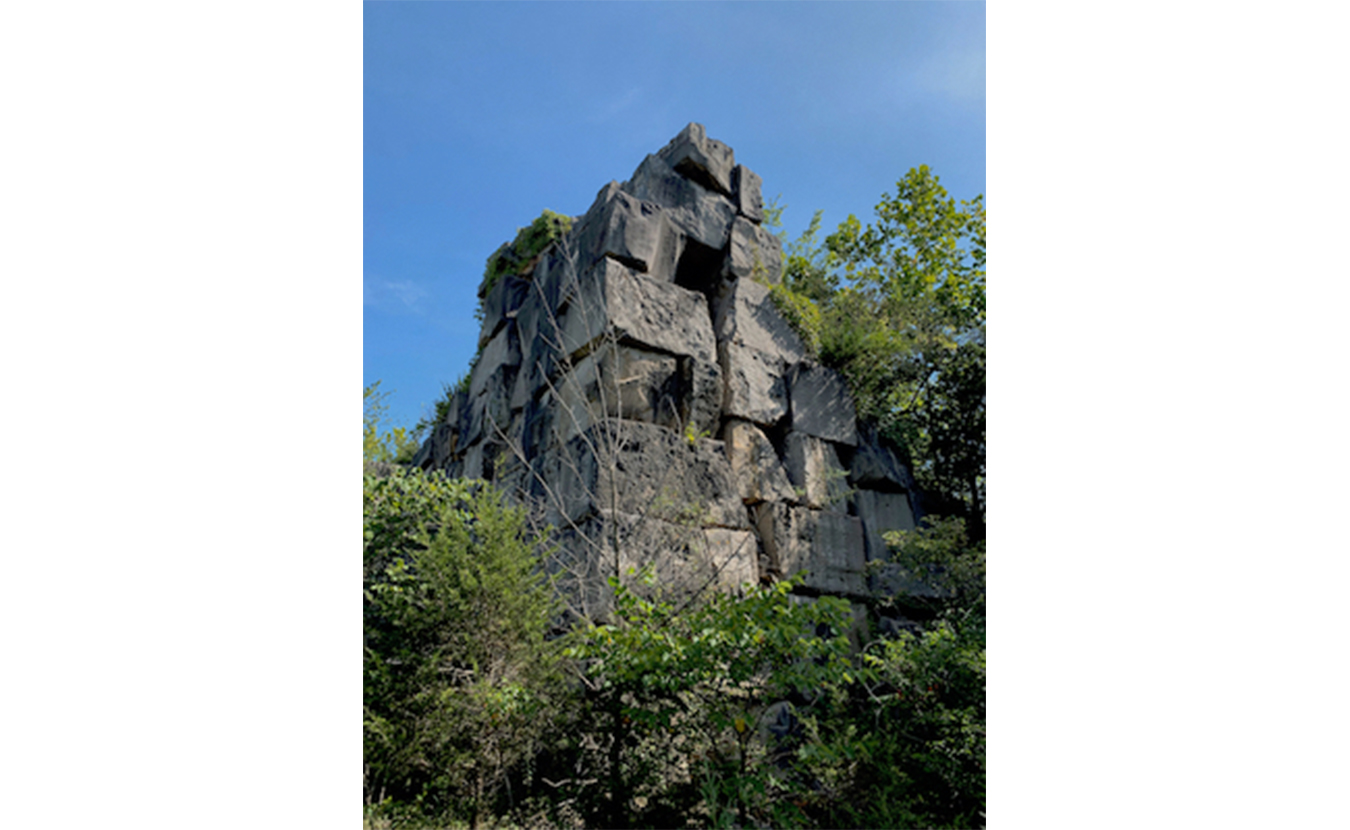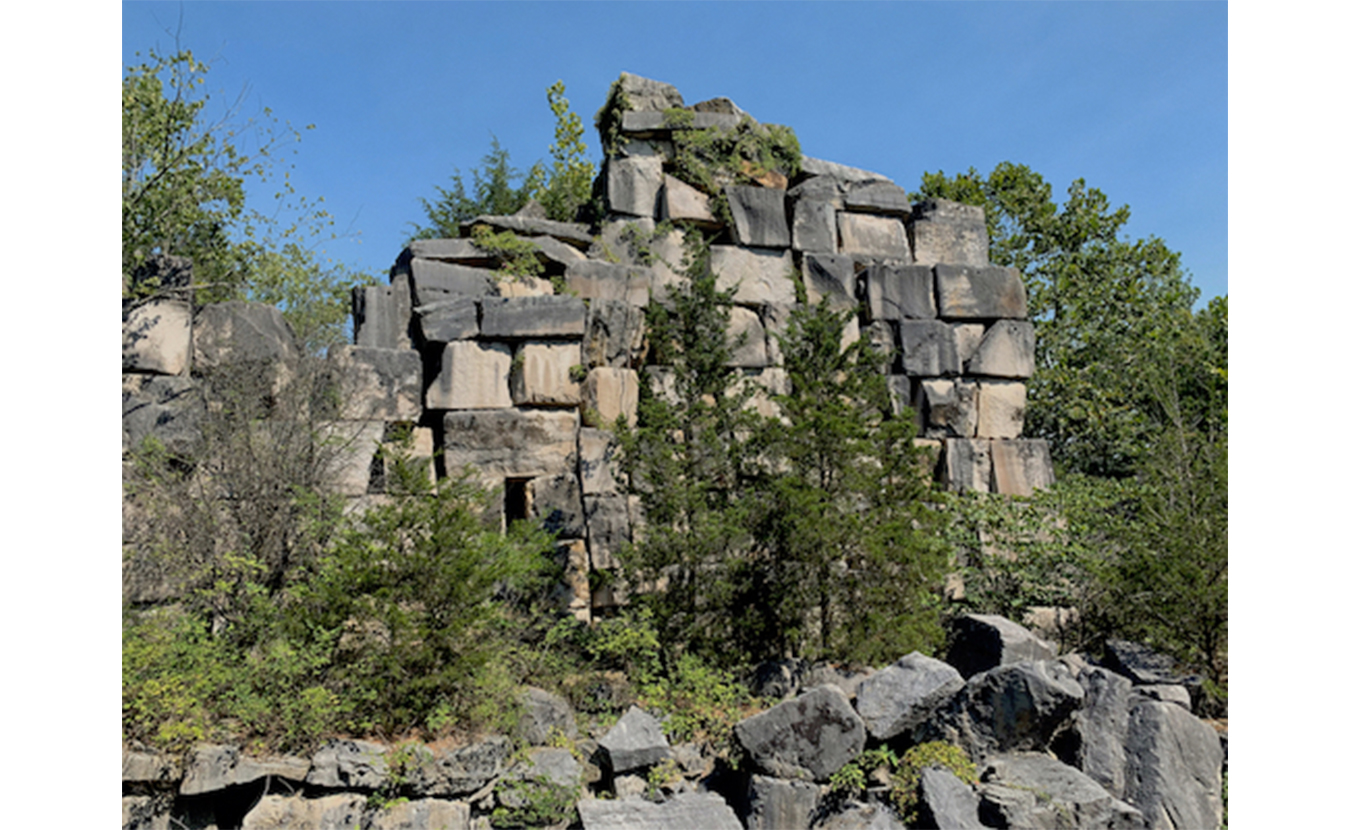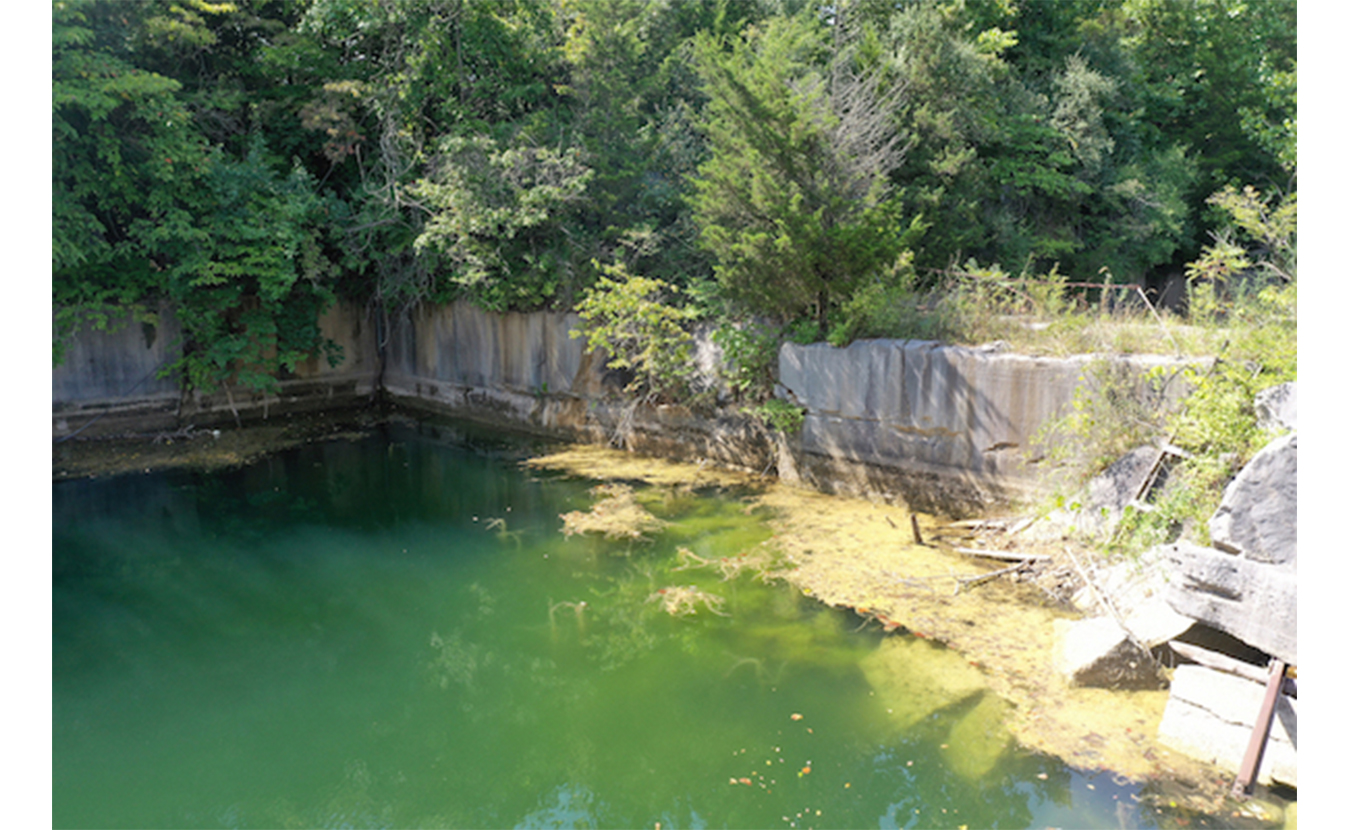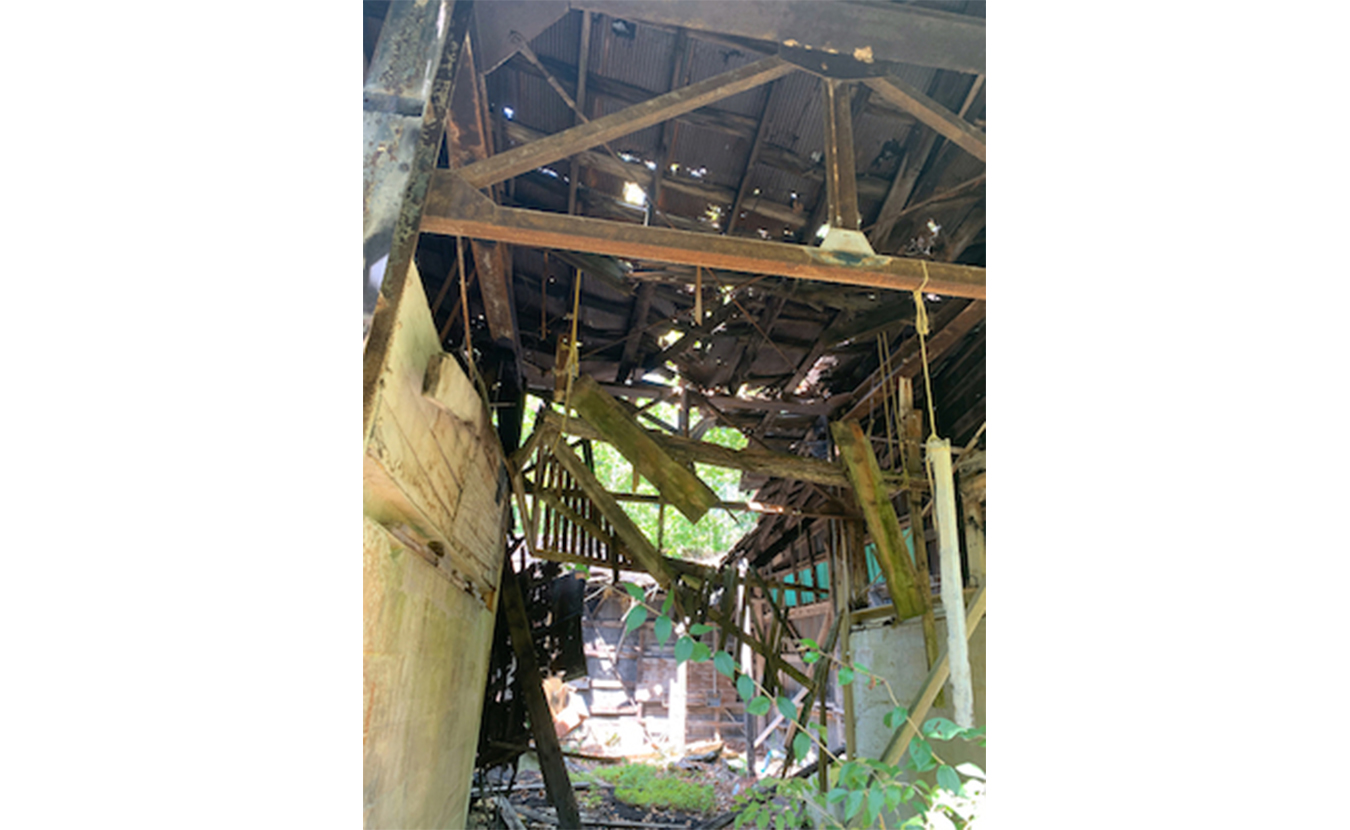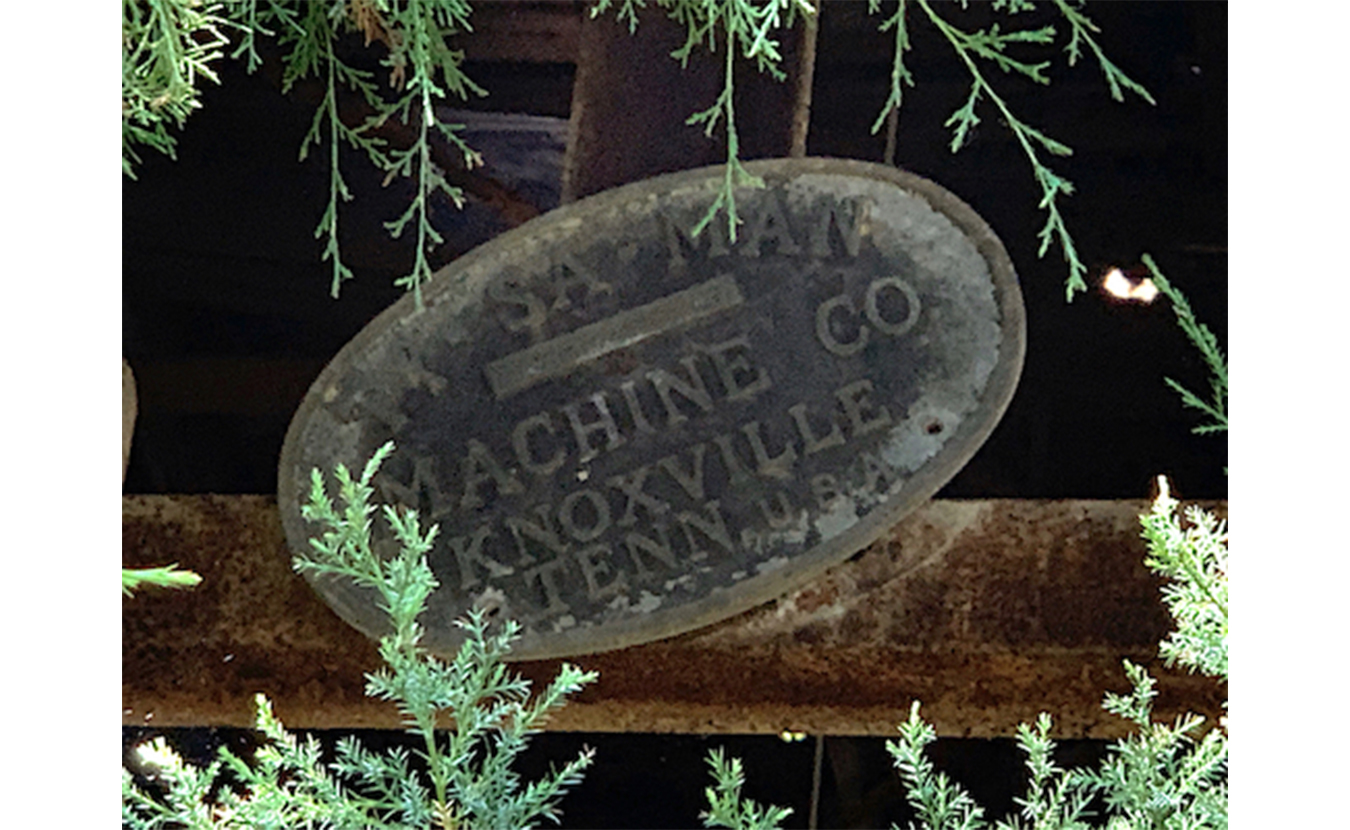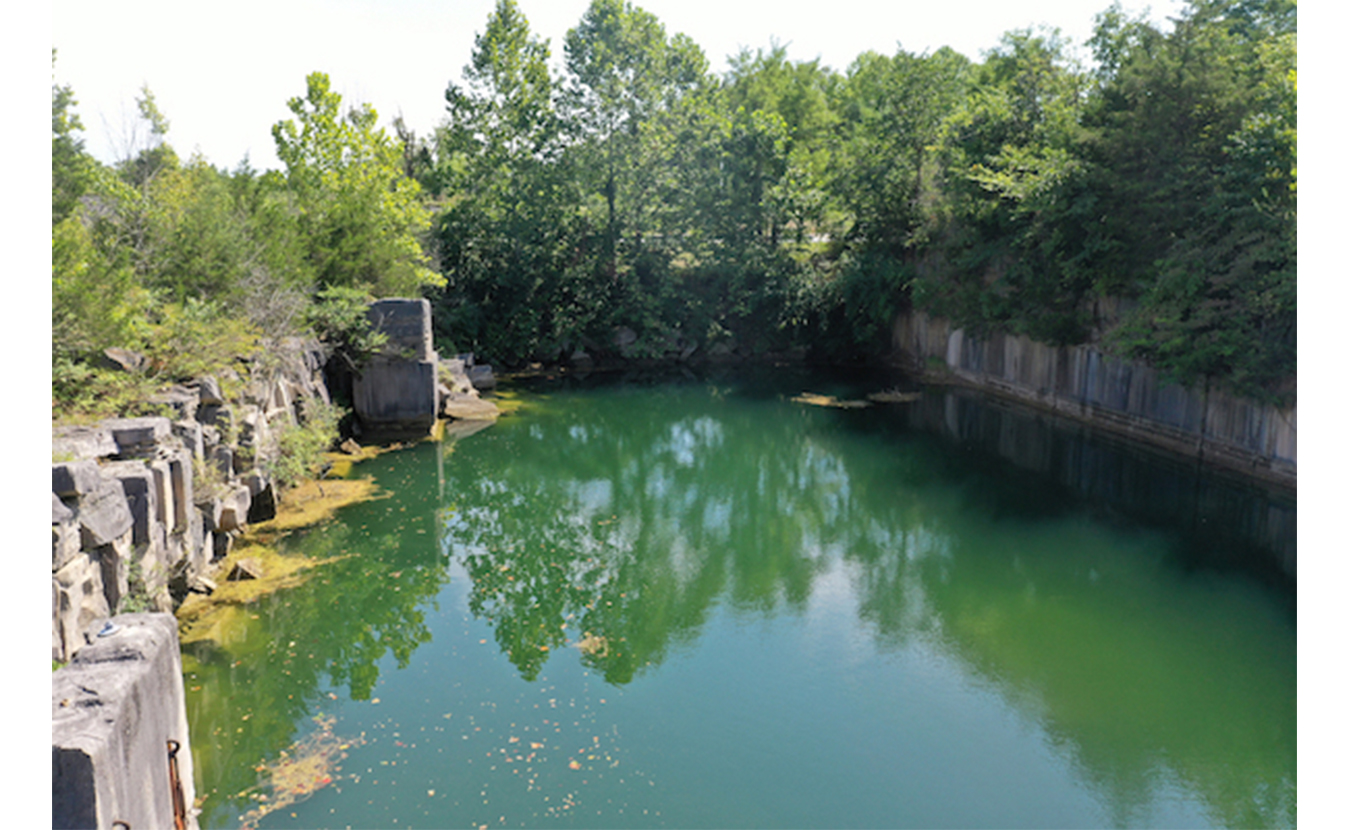Many of Monroe County’s limestone quarries lie hidden in plain sight. A grove of trees along a highway or country road may look like another forested acreage, perhaps sheltering a farmland of soybeans or hay. But behind the trees are acres of rocks piled high and deep. Visitors to a working quarry may be somewhat shocked at the scar the quarries leave upon the landscape. Indiana State Geologist Todd Thompson calls the scraping of soil to uncover the limestone layers below “removing the overburden.” What’s left after the prime building material has been extracted are quarry holes and tons of rubble, plus lots of plastic water bottles tossed aside by workers to be buried after the site is mined out.
Margaret Clements, Monroe County Plan Commission member, fondly remembers quarry swimming with a friend while they were Indiana University undergraduates. She’d take a book and study in the sun after a swim. The 1979 movie Breaking Away spurred hundreds if not thousands of IU students and locals over the years to jump from the 70-foot cliff into Rooftop Quarry — officially Adam’s Quarry — now owned by Indiana Limestone Company (ILC). Nate Waterford, ILC’s environmental, health, and safety director, says that despite their installing surveillance cameras, calling the sheriff’s office for assistance, and hiring security guards, the trespassing continued. Over the years, one swimmer broke both of his legs diving off the 70-foot cliff; another broke her back; and in 2008, Walter Ayala, 18, died after jumping off of the Rooftop cliff.
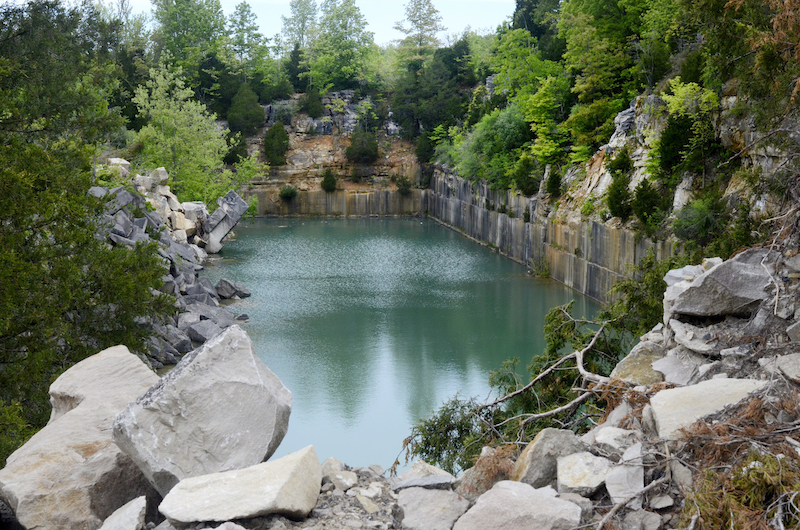
In 2016, Indiana Limestone Company (ILC) gave Limestone Post a tour of iconic Rooftop Quarry in southern Monroe County to show the actions the company took to make the popular swimming hole inaccessible to trespassers, such as bulldozing debris to the top edges of the quarry. In 2018, ILC filled in the quarry with stone and dirt to use as a staging site for stacking blocks of stone. | Photo by Lynae Sowinski
In 2016, ILC offered the property to the city of Bloomington to preserve it and assist in keeping trespassers out. No one was interested, Waterford says, so ILC completely filled in Rooftop with stone and dirt in 2018, and it’s now used as a staging site for stacking blocks of stone.
Still, many visitors highly rate visiting a limestone quarry — whether swimming in it or not — on their list of must-dos. Longtime residents have had their favorite quarries to swim in ever since dormant pits began filling with water. But due to strict safety regulations, limestone quarry owners rarely let visitors on their property, and only then with a company official, hardhats for all, and limited access. Swimming is never on the agenda. About 70 miles northeast of Bloomington, in St. Paul, Indiana, the privately owned White Rock Park does offer swimming in a former quarry hole. Tours of former quarries are available, including activities during June’s Indiana Limestone Month for those who want see an active and former quarry, but not for swimming.
The Monroe County Plan Commission wants to grant the public’s wishes for a quarry visit with a proposed “Quarry in the Uplands” limestone heritage park. For more than 15 years, county officials and others have pursued the idea of a park that would celebrate the history of limestone in the area and educate both locals and visitors about the geology, the art of stonecutting, and the quarry business, as well as possibly reclaim a quarry as a music venue. It finally appears to be closing in on a deal to make that a reality.

Plans for the limestone heritage park include displaying historical quarry machinery, offering stonecutters a place to show their craft, and developing an outdoor museum and entertainment venue. (l-r) Gang saw, photographed by Richard Koenig in a Monroe County dimension mill circa 1980; single-blade circular saw, photographed in Woolery Mill on Bloomington’s southwest side during the mid-1990s; Woolery Mill, 1980. The 1930s building is now an events venue, One World at Woolery, and is designated as a National Historic Landmark. | Photography by Richard Koenig
The county’s quarries
A group of Monroe County commissioners, board members, planning department officials, volunteers, and VisitBloomington staff worked in 2019 to create a proposal for purchasing property to make the park official. The plan was wide-ranging and flexible — to collect historical limestone quarry documents and quarry machinery, offer stonecutters a place to show their craft, have an outdoor museum and entertainment venue, and allow visitors to see what a quarry looks like in person.
In October, the county council approved the issuance of general obligation bonds totaling $3.3 million to pay for a number of projects, including “land acquisition.” The county has received appraisals on 99 acres of land on the northwest corner of I-69 and State Road 46. (A drone video, taken by Monroe County Councillor Geoff McKim, can be viewed at the end of this article.) The former quarry complex comprises eight parcels owned by three different owners and includes seven to nine quarry holes that haven’t been mined for more than 30 years.

Longtime local residents have given some of the more popular quarries different names over the years. Before it was filled in, Rooftop was officially Adams Quarry but was also known as Sanders Quarry. The property being considered for a limestone heritage park includes two quarries that were favorite (if illegal) swimming holes for decades — Long Hole and Ice Box. This photo shows part of Long Hole, which was split in two when SR 46 was constructed. | Photo by Geoff McKim
The proposed property excludes, but nearly surrounds, a 7.25-acre parcel now owned by the CBS Corporation. Beginning in the 1980s, four of those acres were found to be contaminated by polychlorinated biphenyls (PCBs) from electrical capacitors that were likely dumped there by electronics manufacturer Westinghouse, according to the Environmental Protection Agency (EPA). The site was eventually listed as an EPA Superfund site. Although the EPA says “most” cleanup activities finished in 1999, the current owner, CBS, “is performing long-term monitoring and includes monthly sampling of treated water from the Bennett’s Dump spring water treatment plant, water level measurements and monitoring of springs.” County officials say contamination at that site makes it unlikely that a swimmable quarry will ever be a part of the park.
In December, the Monroe County Board of Commissioners received two grants: a quality of place implementation grant for $200,000 from Regional Opportunity Initiatives, an affiliate of the Community Foundation of Bloomington and Monroe County (CFBMC); and a community impact grant for $20,000 from CFBMC.
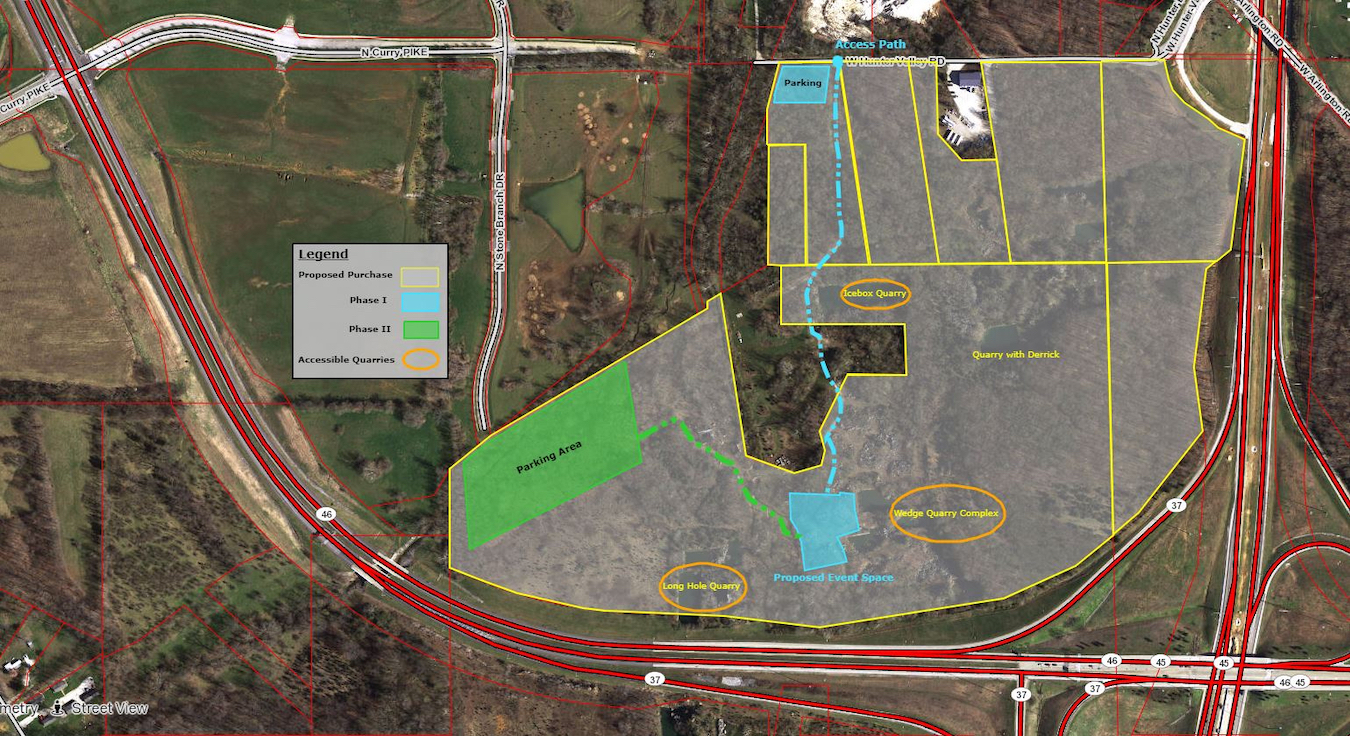
This GIS image shows the properties (shaded) under consideration for the ‘Quarry in the Uplands’ limestone heritage park. If the sale is successful, the park will have seven to nine quarries, but contamination on an adjacent property (the unshaded section in the middle of the proposed purchase) will prevent park officials from developing any of the quarries for swimming. | Courtesy image
Though several county officials have not returned calls or emails to answer questions about its plans to purchase the property, a 70-acre parcel of the property is listed on a commercial real estate site for $950,000. If the sales bid is successful, the county plans to open the property for the Indiana Limestone Symposium in June, where participants learn the craft of stonecutting.
“At the beginning, it will be rustic,” Clements says.
Clements sees the park as a way to reclaim the land for the public good, satisfy curiosity about quarries, honor the county’s limestone history, and serve as a home for artists. It could even help the limestone industry with workforce development. What were once quarry holes that serve as landfills and dumps could be repurposed as a place of pride for locals and visitors. As the county offers various events to see what the public most appreciates, a master plan will be developed.
“We won’t have everything done in two years, or everything done in five,” says Julie Thomas, president of the Monroe County Board of Commissioners. “We’ll see how the community responds.” To gauge public interest, she says, there could be performing arts on a smaller scale using tents. The important part is to have a property first, she says, in order to attract grants.

These maps, courtesy of the Indiana Geological and Water Survey (IGWS), show an area northwest of Bloomington at the interchange of I-69 and State Road 46. The proposed property for Quarry in the Uplands limestone heritage park is north and west of the highways. The left image is a quarry map of the area from 1931. The middle image is the same area using LiDAR topography. In the right image, an IGWS cartographer draped the historic map over the LiDAR map. The National Ocean Service says LiDAR, which stands for Light Detection and Ranging, is ‘a remote sensing method that uses light in the form of a pulsed laser to measure ranges (variable distances) to the Earth.’ | Images courtesy of the Indiana Geological and Water Survey
Work to be done
One problem is that the land is overrun with invasive species such as Asian honeysuckle. “We want to convert a lot of invasive species into native species,” says Jackie Nester Jelen, assistant director of the Monroe County Planning Department. “It’s a pretty immediate concern, but also a long-term effort.” She says the amount of understory makes much of the property impassable, hiding the quarries. “We want to make the quarries visible.”
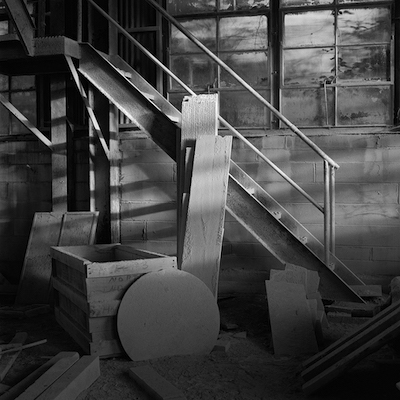
Inside the abandoned Woolery Mill on the southwest side of Bloomington in the mid-1990s. | Photo by Richard Koenig
“We want corporate quarries participating, educating the public about that heritage, preserving that other documentation, worker stories,” Jelen says. “This could be the center of all that information.” She hopes that the industry will offer some financial assistance, as well as providing documents or historic equipment to host on the property.
Todd Schnatzmeyer, executive director of the Indiana Limestone Institute of America, which is based in Bloomington and represents quarriers and fabricators of Indiana limestone, says the park idea has a lot of possibilities. “I think it would be fantastic to have a museum,” he says. “It would be wonderful for me if we could position our offices there. It’s a great concept, but I’m just somewhat reserved in my opinions.”
Schnatzmeyer expressed concerns for costs beyond the initial property purchase without knowing what the development plan is. “Any quarry that you have as a potential venue, first and foremost, needs to be made safe,” he says. “These are industrial sites.” He notes that, while conditions are safer for today’s quarries, how blocks were stored years ago was not well defined. Moving large blocks of limestone requires heavy equipment and skill, he says, and cordoning off quarry holes to keep out curious visitors could be problematic.
But Thomas is optimistic, especially concerning the location of this property, between Ellettsville and Bloomington, with easy access off of I-69 and close to two bike trails. “The potential is unlimited,” she says. “It’s all about working with the local community. It brings people together, and we’re excited about that.”
A limestone history museum, craft demonstrations, outdoor events, and perhaps even a swimming pool with a view of a quarry hole — it won’t be a nostalgic swim in the old Rooftop Quarry, but it would provide an inside look at a 200-year-old industry that has helped shape this region.
[Publisher’s note: In August 2019, Geoff McKim, a member of the Monroe County Council and Monroe County Plan Commission, used a drone to make this video, “Ledge Wall Flyover,” of the property that the Plan Commission intends to develop into the Quarry in the Uplands limestone heritage park. The property is at the northwest corner of I-69 and State Road 46. (Video: 5 minutes)]
‘Ledge Wall Flyover’ | Video by Geoff McKim

